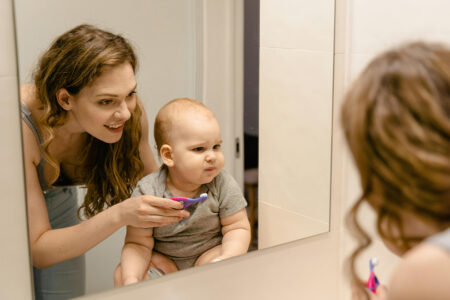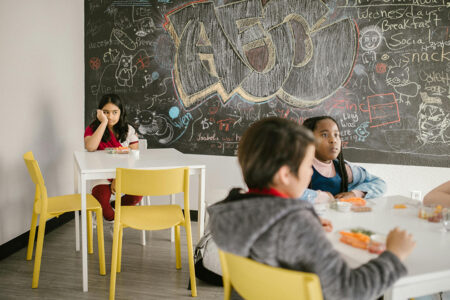“There’s a sign-up sheet on the table!” is the last thing any working parent wants to hear during back-to-school night at a preschool.
If I’m completely honest, I remember being skeptical of it being called back-to-school night in the first place. Yet, here I was, surrounded by parents – most of them younger than me because it was a back-to-school night for my youngest child – clambering to fill out a playdough sign-up sheet.
This was sixteen years ago and we had just switched to this preschool closer to our new home. When I finally got hold of the playdough sign-up sheet, my annoyance turned to horror as I saw that not only was I required to provide enough playdough for a dozen 3-year-olds, but they wanted me to make it.
I still squirm a bit picturing the look on the preschool teacher’s face as I asked her in what I’m quite sure was a dreadful tone: “Can I just buy it. You know, like at Target?”
As she handed me the recipe for homemade playdough (which is linked with video from the Children’s Museum here), she explained how it was something the kids and I could do together in the kitchen and that we probably had all the necessary ingredients in a cabinet at home.
Of course, she was right. We even had cream of tartar – which to this day, I have no idea why we had it or if we ever used it again for anything else, other than making playdough. Soon after I was forced by this militant, albeit delightful preschool teacher to make playdough, we immediately became addicted and never bought it at a store again.
Over the years, in addition to the miracle of playdough parenting, I discovered all kinds of ways to build what I called our smartistic muscles at home. Here are a few of my strategies for raising creative kids:
1. Inspire imaginative play. When it comes to imaginative play, a dress-up box is essential. Here’s what we had in ours: the handset from an old phone, the blue shoes I wore in my best friend’s wedding, Mardi Gras beads, birthday party hats, gloves and floppy hats from Goodwill, scarves, neckties, a tool belt, a briefcase, pieces and parts from Halloween costumes, and superhero capes.
Generally, when planting the seeds for creative play, think about what your kids like. Kids like birthday parties, and the good news is, the dog, cat, or a loved-on stuffed bunny can have a birthday once a week! The kids will need to plan a menu, figure out games, and make invitations, party favors, and hats. My kids also used to reenact their favorite books and play pretend store and restaurant. And yes, now is the perfect time to play school at home.
2. Encourage kids to show their stuff. Want to inspire creativity in your kids? Try these four words: How about a show? At our house, the family room or driveway was usually center-stage. Shows and plays came in all shapes and sizes – with the final production depending on average age level of the cast. As with any special event, getting ready for the show was the best part. There were costumes to consider, and sets and backgrounds to design. If you’re lucky, most of this preparation will take place as independent play. But when it’s showtime, Mom or Dad will probably need to take a front row seat.
3. Turn up the music. “Why do you always have music playing at your house?” is a question my kids heard often from friends. The answer, quite simply, was because Mommy liked it. I don’t think I realized how important music was for my kids’ creativity until I watched a 6-year-old neighbor child walk into our family room, turn on the TV, and sit in front of it mesmerized. In our home, my kids had to ask me to turn off the music before they could turn on the TV. I honestly don’t know if this strategy would work in the age of multiple small screens, but when my kids were little, background music was the order of the day and this meant far less exposure to other media.
4. Give kids easy access to supplies. I can’t remember who first told me to store arts and crafts supplies in a kid-accessible place, but I do remember thinking it would never work. Then I discovered the splat mat. Our splat mat of choice was an old shower curtain. Whenever glue, markers, paint, glitter, or playdough (homemade or store-bought) were involved, the kids hauled out the splat mat. We also kept a box for stuff we might use one day. This is where we stashed items that could be up-cycled – think toilet paper tubes, plastic water bottles, cardboard, etc. Over the past month, I have seen a wealth of crafts and other ideas for creative play from CVWMA (and some of them use our family-favorite playdough). Definitely check them out on Instagram at @CVWMA if you get a chance.
Which leads me to why I was inspired to write about creative play this month. It has been a strange and scary time for everyone, to say the least. But I have been inspired by the many fantastic resources and ideas – both tactile and digital – to keep kids engaged and parents and caregivers from losing it completely. From the look of things, we are learning a lot about our families and our parenting. It is my belief that if we strive to stay patient and compassionate with our kids and with each other, we will come out on the other side of this stronger. Also, we’ll have a lot less cream of tartar and a lot more creativity.







